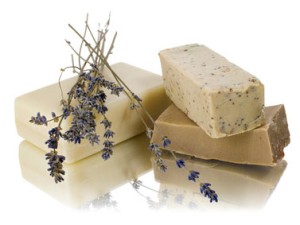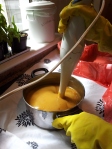This is my favourite DIY natural soap recipe. Like all my other natural product recipes, it’s palm oil free. If you’re wondering why this is then please take a look at this article – I wrote it some time back, and it should answer all of your questions: Palm oil, the good, the bad and the downright ugly
Here’s what you need:
Two large saucepans (or one saucepan and one bucket)
Rubber gloves, eye protection and a thick apron
A stick/hand blender
A couple of wooden spoons (or stainless steel are fine, as long as they are long handled)
Measuring scales
Soap or baking moulds
A sharp knife
*Note: Do not use any items that touch the lye, for anything else other than soap making.
Ingredients:
500 g (20 oz) coconut oil
150 g (6 oz) shea butter (I love this butter!)
350 g (14 oz) olive oil
330 g (13 oz) filtered water
154 g (6 oz) sodium hydroxide (lye) – Never touch this without protective gear on!
3 medium figs (or at Christmas I’ve used cranberries and cinnamon essential oil)
15 ml (1 tbs) honey
5 ml (1 tsp) grape-seed oil or vitamin E oil
15 ml (3 tsp) of a selection of essential oils (I like ylang ylang, frankincense and jasmine – but this is completely up to you).
Directions:
1. Weigh out all the oils to add to one of your large saucepans (or your bucket). The grape-seed oil/vitamin E Oil and essential oils should not be included at this stage.
2. Add olive oil and coconut oil as they are but as you add the shea butter cut it up into small pieces (so it melts easier when the lye is added later on). 
3. Put on all your protective gear (apron, gloves and eye protection).
4. Measure out your water and add to the saucepan you’re not using yet.
5. Then measure out your sodium hydroxide (lye) and add to the water. Make sure you do this in a very well ventilated area!
6. Stir the water and lLye mixture with a wooden spoon until the lye has completely dissolved.
7. Cut the stem off the figs and cut into quarters and liquidise with your stick blender.
8. Add the figs and the honey to the lye and water mixture and stir until dissolved.
9. Add the lye, water, honey and fig mixture to your oil mixture in the other saucepan and stir with your wooden long handled spoon until all the oils have melted completely.
10. Once there are no lumps of oil left begin to mix the mixture with your stick blender until it comes to trace (this means the stick blender leaves patterns in the mixture when moved around in it).
11. Add the grape-seed/vitamin E oil and your choice of essential oils at this stage and stir through mixture.
12. Put your moulds (for making up to 1.5 kg (3 lb) of product) onto a tray (so they are easily moved to a safe place later to cure).
13. Pour the mixture into moulds and move to a safe place. Remember at this stage you should still be careful not to touch the mixture yourself as the pH level of the soap mixture will be highly acidic.
14. Allow the soap mixture to set for at least 48 hours (in some cases a day or two longer), until set but still a little soft.
15. Wearing gloves take the soap mixture out of the moulds. If you used a large soap mould then cut your soap up into individual portions at this stage.
16. Now leave the soaps for a further 6 weeks to cure. Do not use them before this time without performing a pH test on them to check they are now safe to use.
Now Enjoy!





